JavaScript is disabled for your browser. Some features of this site may not work without it.
Buscar en RiuNet
Listar
Mi cuenta
Estadísticas
Ayuda RiuNet
Admin. UPV
Growth, carcass and caecal traits in V-line and crossbred rabbit fed diets containing discarded dates
Mostrar el registro completo del ítem
Al-Dobaib, S.; Khalil, M.; Hashad, M.; Al-Saef, A. (2007). Growth, carcass and caecal traits in V-line and crossbred rabbit fed diets containing discarded dates. World Rabbit Science. 15(2):81-90. https://doi.org/10.4995/wrs.2007.603
Por favor, use este identificador para citar o enlazar este ítem: http://hdl.handle.net/10251/7406
Ficheros en el ítem
Metadatos del ítem
| Título: | Growth, carcass and caecal traits in V-line and crossbred rabbit fed diets containing discarded dates | |
| Autor: | Al-Dobaib, S.N. Khalil, M.H. Hashad, M. Al-Saef, A.M. | |
| Fecha difusión: |
|
|
| Resumen: |
[EN] A total of 78 rabbits representing two genetic groups of V-line and crossbred of V-line x Saudi Gabali were used to evaluate dietary treatments containing discarded dates (DD) for post-weaning growth performance, feed ...[+]
|
|
| Palabras clave: |
|
|
| Derechos de uso: | Reserva de todos los derechos | |
| Fuente: |
|
|
| DOI: |
|
|
| Editorial: |
|
|
| Versión del editor: | https://doi.org/10.4995/wrs.2007.603 | |
| Agradecimientos: |
The authors are grateful to the Agricultural and Veterinary Research Center, College of Agriculture and Veterinary Medicine, Al-Qassim University, Saudi Arabia for funding this study. We are also grateful to Mr. Fahad ...[+]
|
|
| Tipo: |
|








